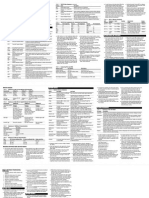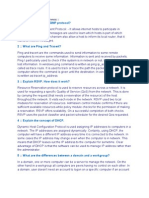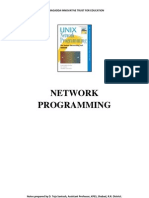Ethernet Services
Ethernet Services
Uploaded by
Rodrigo GuzmanCopyright:
Available Formats
Ethernet Services
Ethernet Services
Uploaded by
Rodrigo GuzmanCopyright
Available Formats
Share this document
Did you find this document useful?
Is this content inappropriate?
Copyright:
Available Formats
Ethernet Services
Ethernet Services
Uploaded by
Rodrigo GuzmanCopyright:
Available Formats
Art.
no 3HAC 7844-1
Ethernet Services
CONTENTS
Page
1 Overview .......................................................................................................................... 3 1.1 Requirements for using the Ethernet Services........................................................ 3 1.1.1 Controller Hardware .................................................................................... 3 1.1.2 Controller Software...................................................................................... 3 1.1.3 External Computer (PC) Software ............................................................... 4 2 Remote Mounted disk ..................................................................................................... 5 2.1 Overview ................................................................................................................ 5 2.2 Server and local path .............................................................................................. 5 2.3 Error handling......................................................................................................... 5 2.4 Authorization .......................................................................................................... 6 2.4.1 NFS .............................................................................................................. 6 2.4.2 FTP............................................................................................................... 6 2.5 Software on external computer............................................................................... 6 3 Protocols........................................................................................................................... 7 4 References ........................................................................................................................ 9
Ethernet Services Users Guide
Ethernet Service
Ethernet Services User s Guide
Ethernet Services
Overview
1 Overview
This document describes the functionality of the Option Ethernet Services and Ethernet services with FTP. This option has the following functionality: Remote Mounted Disks Access of the hard drive of an external computer from the controller
External Computer (e.g. a PC)
Ethernet TCP/IP Figure 1 The Ethernet services are all based on controller connected to a external computer. Note that the ethernet cable configuration in the picture are only drawn in a schematic manner. The real configuration varies depending on what type of ethernet is used.
1.1 Requirements for using the Ethernet Services
1.1.1
Controller Hardware The following Controller Hardware is required for the Ethernet Services: S4Cplus
1.1.2
Controller Software Ethernet Services or Ethernet services with FTP Option
Ethernet Services User s Guide
Overview
Ethernet Services
1.1.3 External Computer (PC) Software Both services TCP/IP stack Remote Mounted disk NFS Server or FTP server
Ethernet Services User s Guide
Ethernet Services
Remote Mounted disk
2 Remote Mounted disk
2.1 Overview
Remote mounted disks enables the user to access files stored on a disk. The external computer has a NFS or FTP server software running which will enable the robot to access the files on its disks. Since several robots can access the disk of the same external computer the PC disk can be used as a backup storage for robot programs, system parameters etc.
2.2 Server and local path
The disk are exported by the NFS/FTP server running on the external computer. They are exported under a name that can be setup on the server. The C drive on a PC can for example be exported under the name /C. This name should be entered in the system parameters in the Server Address parameter. Note that the server does not have to export the whole disk but can export a sub tree of a disk. E.g. c:\rbt_backup can be exported as /c/rbt_backup. The Local Path parameter specifies the name of the mounted unit on the robot. This name is displayed on the teach pendant in the list of units together with the ram1disk: and flp1: unit. It is also used in the RAPID programming language for accessing files. See the User s Guide for information about how to change parameters. Example Assume that the external computer exports the sub directory c:\robot as /c/robot and that a robot system mounts this disk as pc:. The file c:\robot\robot.prg can then be accessed as pc:/robot.prg on the robot.
2.3 Error handling
The robot controller periodically checks the connection to the server. The behaviour when the connection is lost can be controller by changing the Trusted flag in the system parameters. See the User s Guide for information about how to change parameters. Non-trusted units If the flag is set to No a warning will be generated reporting that the server has gone Ethernet Services User s Guide 5
Remote Mounted disk
Ethernet Services
down. Accessing the unit after the error message has been given will result in an error. Trusted units If the flag is set to Yes an error will be generated, the RAPID program will stop and the controller will switch to motors off mode.
2.4 Authorization
2.4.1 NFS The NFS protocol specifies a way of authorizing the user to access a specific server. These parameters are setup using the User ID and Group ID parameters. If these parameters are not used which usually is the case on a PC, set them to the default value 0. Note that these two parameters must be the same for all mountings on one robot controller.
2.4.2
FTP FTP makes it possible to control the access to the server. The user has to have an account to login on the server. The account specifies username and a password. Note that the password will be visible on the TPU and in the configuration file, sio.cfg.
2.5 Software on external computer
The external computer needs the following software: TCP/IP stack NFS or FTP Server
Ethernet Services User s Guide
Ethernet Services
Protocols
3 Protocols
RAP, remote mounted disk and booting via network are all based on the TCP/IP protocol suite. TCP/IP is not vendor-specific and is widely used both for Wide and Local Area Networks. RAP NFS FTP
RPC/XDR
TCP/IP protocol suite TCP UDP
ICMP
IP
PPP
Ethernet
Figure 2 The protocols used for the Communication in the S4C controller
Figure 2 shows the protocols used in the controller. All protocols except the Robot Application Protocol (RAP) are standard protocols. The list below briefly explains the function of each protocol and includes references for further information. PPP PPP is a de-facto standard for point-to-point serial connections running TCP/ IP. It is used in the controller for RAP-communications via a serial line. Ethernet Ethernet is a common standard for communication in networks. It was developed by Xerox Corporation 1976. The standard IEEE802.3 was developed from the original ethernet. Information is transferred in packets on the cable. When a node wants to send a packet, it first checks that there is no traffic on the line. In that case it waits a while. This technique for collision detection is called CSMA/CD, Carrier Sense Multiple Access with Collision Detection. The transmission rate is 10Mbit/s and there are four different cabling systems Thick (standard ethernet) with thick (10mm) coaxial cables, thin ethernet with thinner (5mm) coaxial cables, fibre optic ethernet and Twisted pair cables. References: Nemzov, The Ethernet management guide: keeping the link. Ethernet Services User s Guide 7
Protocols
Ethernet Services
IP Internet Protocol, IP provides a packet delivery service for TCP, UDP and ICMP. ICMP Internet Control Message Protocol handles errors and control information between gateways and hosts in the network. This messages are normally generated and handled within the TCP/IP networking software. TCP Transmission Control Protocol is a connection-oriented protocol that provides a reliable full-duplex stream. TCP guarantees that the messages reach their intended destination. UDP A connectionless protocol. UDP does not guarantee that the messages reach the indented destination. This has instead to be handled by the overlaying protocols RPC/XDR Remote Procedure Call/eXternal Data Representation. RPC is a protocol for invoking a procedure on an remote machine. For the user of the RPC calls it appears like they are executed on the local machine, i.e. the network is transparent. XDR provides a standardized form for transmission of data between different computers. The controller uses Sun/RPC Version 4.0r NFS Network File System NFS is a protocol developed by Microsystems that uses IP to allow a computer to access the file system of another computer. FTP File Transfer Protocol FTP provides file transfer using TCP/IP. FTP copies a complete file from one system to another system.
Ethernet Services User s Guide
Ethernet Services
References
4 References
1 RAP Protocol Specification (ABB Flexible Automation) 2 RAP Service Specification (ABB Flexible Automation) 3 User s Guide (ABB Flexible Automation) 4 RobComm User s Guide (ABB Flexible Automation) 5 Nemzow, Martin A. W., The Ethernet management guide: keeping the link. 2nd ed., McGraw-Hill, 1992. ISBN 0-07-046320. 6 Power Programming with RPC by John Bloomer, OReilly & Associates, Inc. ISBN 0-937175-77-3 7 Comer, Douglas E., Internetworking with TCP/IP, Prentice-Hall International, Inc. Vol I-III. 8 A number of RFCs. These are the standard document for the Internet protocols. They can be downloaded from the internet from several sites.: - RFC 760 IP - RFC 761 and 793 TCP - RFC 768 UDP - RFC 1050 RPC - RFC 1094 NFS - RFC 959FTP
Ethernet Services User s Guide
References
Ethernet Services
10
Ethernet Services User s Guide
You might also like
- Network+ Exam Cram Study SheetDocument3 pagesNetwork+ Exam Cram Study SheetDan Sheets86% (21)
- ABBDocument84 pagesABBRodrigo Guzman100% (2)
- MCSE Questions and AnswersDocument14 pagesMCSE Questions and Answersnareshgotad65No ratings yet
- Cisco Ccna 200-301 Exam Q&A PDFDocument72 pagesCisco Ccna 200-301 Exam Q&A PDFAmaNo ratings yet
- CCNA 1+2+3+4 v5Document87 pagesCCNA 1+2+3+4 v5Ajmal QalaNo ratings yet
- Serial Port Complete: COM Ports, USB Virtual COM Ports, and Ports for Embedded SystemsFrom EverandSerial Port Complete: COM Ports, USB Virtual COM Ports, and Ports for Embedded SystemsRating: 3.5 out of 5 stars3.5/5 (9)
- LAN MessengerDocument57 pagesLAN MessengerMudit Dhawan100% (4)
- ACE TutorialDocument159 pagesACE TutorialMostafa AhmedNo ratings yet
- EthservDocument18 pagesEthservredoctober24No ratings yet
- Introduction To Networks Version 70 ITNv7 Practice Final Exam AnswersDocument27 pagesIntroduction To Networks Version 70 ITNv7 Practice Final Exam AnswersTemam MohammedNo ratings yet
- Questions and Answers - ProtocolsDocument4 pagesQuestions and Answers - ProtocolsVishal PaupiahNo ratings yet
- Remote Desktop Protocol (RDP) : IpconfigDocument5 pagesRemote Desktop Protocol (RDP) : Ipconfigpry_kumNo ratings yet
- CCNA 1 Final Exam AnswersDocument80 pagesCCNA 1 Final Exam AnswersTatenda BizureNo ratings yet
- Chapter OneDocument13 pagesChapter OnemenbereNo ratings yet
- TCPIP ModelDocument9 pagesTCPIP Modelroysayanccp05No ratings yet
- CCNA 1 v7.0 Final ExamDocument62 pagesCCNA 1 v7.0 Final ExamDonald TientcheuNo ratings yet
- CCNA 1 RS Introduction To Networks Final Exam v50 2013Document15 pagesCCNA 1 RS Introduction To Networks Final Exam v50 2013daniel_afpNo ratings yet
- Switch and Router ConfigurationDocument41 pagesSwitch and Router ConfigurationBroot KalNo ratings yet
- Hct6000 Tcpip OptionDocument14 pagesHct6000 Tcpip OptionGerman DfrNo ratings yet
- Cisco 1 Reviewer For Final ExamDocument9 pagesCisco 1 Reviewer For Final ExamAlNo ratings yet
- CCNA 1 v5.0 R&S ITN Final Exam Answers 2014Document22 pagesCCNA 1 v5.0 R&S ITN Final Exam Answers 2014jonmicNo ratings yet
- DsmbISP Final Exam - CCNA Dicovery Working at A Small-To-Medium Business or ISP (Version 4.1) Final 2Document13 pagesDsmbISP Final Exam - CCNA Dicovery Working at A Small-To-Medium Business or ISP (Version 4.1) Final 2JesusforgivemeNo ratings yet
- M - BSM Basic Sys Manage XeDocument12 pagesM - BSM Basic Sys Manage XeGVNo ratings yet
- Programming With TCP/IP - Best PracticesDocument31 pagesProgramming With TCP/IP - Best PracticesmrwanzNo ratings yet
- Study Guide ExpandedDocument7 pagesStudy Guide ExpandedGabby ShearerNo ratings yet
- Pom 11Document7 pagesPom 11nexus5restoreNo ratings yet
- Basics of Networking: Computer Network DesignDocument41 pagesBasics of Networking: Computer Network DesignranjeetNo ratings yet
- NETWORKPROGRAMMINGNP8UNITSDocument139 pagesNETWORKPROGRAMMINGNP8UNITSYogeswaran NathanNo ratings yet
- Unit-5 NotesDocument45 pagesUnit-5 NotesMOGILIPURI KEERTHINo ratings yet
- Take Assessment - DsmbISP Final Exam - CCNA Discovery - Working at A Small-To-Medium Business or ISP (Version 4.1)Document8 pagesTake Assessment - DsmbISP Final Exam - CCNA Discovery - Working at A Small-To-Medium Business or ISP (Version 4.1)Manjula RathnathilakeNo ratings yet
- The OSI Network Model StandardDocument10 pagesThe OSI Network Model Standardcheal_che2No ratings yet
- Diorey Practice ExamDocument22 pagesDiorey Practice ExamYeroid Diorey PotestasNo ratings yet
- Multiprotocol Label Switching (MPLS) Is A Mechanism in High-PerformanceDocument6 pagesMultiprotocol Label Switching (MPLS) Is A Mechanism in High-Performancetasnim tamannaNo ratings yet
- Typical CCNA QuestionDocument4 pagesTypical CCNA QuestionkeoghankNo ratings yet
- Physical Layer Data Link Layer: Logical Link Control (LLC) Media Access Control (MAC)Document44 pagesPhysical Layer Data Link Layer: Logical Link Control (LLC) Media Access Control (MAC)GauravNo ratings yet
- Unit 3Document9 pagesUnit 3bhandaribidhya197No ratings yet
- Tutorial Week 1Document4 pagesTutorial Week 1Lasse IngdahlNo ratings yet
- Osi ModelDocument11 pagesOsi ModelMu Asif KhNo ratings yet
- Ictnwk542 Task1Document6 pagesIctnwk542 Task1jauynepalNo ratings yet
- Ccna1 Final Exam1 2011 MaxDocument17 pagesCcna1 Final Exam1 2011 MaxAtu Tubagus Ali, STNo ratings yet
- Take Assessment - Enetwork Final Exam - Ccna Exploration: Network Fundamentals (VERSION 4.0) - ANSWERS - 2011 - 2012Document6 pagesTake Assessment - Enetwork Final Exam - Ccna Exploration: Network Fundamentals (VERSION 4.0) - ANSWERS - 2011 - 2012Juan Jose TorresNo ratings yet
- Network Programming NotesDocument138 pagesNetwork Programming NotesLaxman YadavNo ratings yet
- Sysnet Notes: Basic CCNA Interview Questions AND AnswersDocument8 pagesSysnet Notes: Basic CCNA Interview Questions AND AnswersReddy SumanthNo ratings yet
- Modules 9Document22 pagesModules 9Pamela VegaNo ratings yet
- Network Layers: The OSI Network Model StandardDocument4 pagesNetwork Layers: The OSI Network Model StandardPrasanna Venkatesan100% (1)
- Week 2Document146 pagesWeek 2gojan39660No ratings yet
- MCSE Questions and Answers:: 1:: What Is The Use of IGMP Protocol?Document14 pagesMCSE Questions and Answers:: 1:: What Is The Use of IGMP Protocol?Sivaprasad-hunt BeginsNo ratings yet
- Introduction To TCP/IP: CT4005NIDocument27 pagesIntroduction To TCP/IP: CT4005NISandesh ShiwakotiNo ratings yet
- Unit Iii: by Sowmya MadhavanDocument21 pagesUnit Iii: by Sowmya MadhavanSowmya MadhavanNo ratings yet
- TCP IP Protocol Architecture ModelDocument6 pagesTCP IP Protocol Architecture Modelayesha chNo ratings yet
- Networking Basics Notes - v2Document45 pagesNetworking Basics Notes - v2Gherasa Marius BogdanNo ratings yet
- Daystar University ACS 351 A Computer Networks 1Document12 pagesDaystar University ACS 351 A Computer Networks 1Marilene Soulfly MercyNo ratings yet
- TCP IP TrbshootDocument20 pagesTCP IP TrbshootsybaritzNo ratings yet
- NetworkingDocument2 pagesNetworkingbubu nakiNo ratings yet
- CCNA 1 FINAL Exam Answers v5.0 2013Document0 pagesCCNA 1 FINAL Exam Answers v5.0 2013CCNA5.NETNo ratings yet
- Cisco Interview QuestionsDocument8 pagesCisco Interview QuestionsssprudhviNo ratings yet
- Manual A4 20200617 01Document49 pagesManual A4 20200617 01sunrayNo ratings yet
- CISCO PACKET TRACER LABS: Best practice of configuring or troubleshooting NetworkFrom EverandCISCO PACKET TRACER LABS: Best practice of configuring or troubleshooting NetworkNo ratings yet
- Computer Networking: An introductory guide for complete beginners: Computer Networking, #1From EverandComputer Networking: An introductory guide for complete beginners: Computer Networking, #1Rating: 4.5 out of 5 stars4.5/5 (2)
- LEARN MPLS FROM SCRATCH PART-B: A Beginners guide to next level of networkingFrom EverandLEARN MPLS FROM SCRATCH PART-B: A Beginners guide to next level of networkingNo ratings yet
- Panel Builder 1400eDocument114 pagesPanel Builder 1400eRodrigo GuzmanNo ratings yet
- Rapid Reference 2.1Document759 pagesRapid Reference 2.1Rodrigo GuzmanNo ratings yet
- Cable Serial Rs232 para Panel ViewDocument2 pagesCable Serial Rs232 para Panel ViewRodrigo Guzman50% (2)
- Operators Manual PowerWave 455mDocument42 pagesOperators Manual PowerWave 455mJohan ZraghozNo ratings yet
- Ora Net 0cDocument13 pagesOra Net 0cYulin LiuNo ratings yet
- Final Term Paper Internet Architecture and ProtocolDocument1 pageFinal Term Paper Internet Architecture and ProtocolFaisal IzharNo ratings yet
- Tshark - The Wireshark Network Analyzer 3.0.1Document21 pagesTshark - The Wireshark Network Analyzer 3.0.1wariszNo ratings yet
- M5 Questions and AnswersDocument14 pagesM5 Questions and AnswersAвнιѕнєк SVNo ratings yet
- JX-300XP System OverviewDocument37 pagesJX-300XP System Overviewsugeng wahyudiNo ratings yet
- User Datagram ProtocolDocument33 pagesUser Datagram ProtocolEco Frnd Nikhil ChNo ratings yet
- Asterisk Call IssueDocument239 pagesAsterisk Call IssueSithu AungNo ratings yet
- 4) Physical Design of IotDocument29 pages4) Physical Design of IotAkshaya BNo ratings yet
- Network Simulation Using NctunsDocument7 pagesNetwork Simulation Using NctunsSushanth KengunteNo ratings yet
- CompTIA Certkiller N10-006 v2015-03-28 by Veronica 124q PDFDocument61 pagesCompTIA Certkiller N10-006 v2015-03-28 by Veronica 124q PDFtrudiva tagNo ratings yet
- Sitsyll PDFDocument57 pagesSitsyll PDFpreranaNo ratings yet
- NI Tutorial 12402 enDocument6 pagesNI Tutorial 12402 enMisael Castillo CamachoNo ratings yet
- Isro Scientist Sample PaperDocument22 pagesIsro Scientist Sample Papervenkatesh chavvakulaNo ratings yet
- Jawaban Jarkon 14-15 (B.inggris)Document19 pagesJawaban Jarkon 14-15 (B.inggris)Victor Carolus Patria BelareqNo ratings yet
- Udp Hole PunchingDocument31 pagesUdp Hole PunchingVivek ChughNo ratings yet
- Jntuh Iot Le Cture NotesDocument92 pagesJntuh Iot Le Cture NotesMrs.SHEEBA MNo ratings yet
- Network Programming in JavaDocument66 pagesNetwork Programming in JavaarunlaldsNo ratings yet
- IOT Homework 4 NaveenDocument7 pagesIOT Homework 4 NaveenNaveen ThirunilathNo ratings yet
- Chapter 4Document15 pagesChapter 4Bezabh AbebawNo ratings yet
- 1167 - DCC MicroProject (1) - 1Document19 pages1167 - DCC MicroProject (1) - 1Aryan ShenoyNo ratings yet
- Contain Slides by Leon-Garcia and WidjajaDocument56 pagesContain Slides by Leon-Garcia and WidjajaAnonymous 6iFFjEpzYjNo ratings yet
- Data and Computer Communications: Tenth Edition by William StallingsDocument44 pagesData and Computer Communications: Tenth Edition by William StallingsAlexa RobinsNo ratings yet
- EnerVista UR SetupDocument13 pagesEnerVista UR SetupcuamiNo ratings yet
- RTA - EtherNet - IP and TCP - IP - Real Time Automation, IncDocument8 pagesRTA - EtherNet - IP and TCP - IP - Real Time Automation, InczeinNo ratings yet
- Transport Layer Protocols: CSE 123: Computer Networks Stefan SavageDocument33 pagesTransport Layer Protocols: CSE 123: Computer Networks Stefan SavageKatlego MaplankaNo ratings yet
- Lesson ObjectivesDocument5 pagesLesson ObjectivesWinny Shiru MachiraNo ratings yet
- User Datagram Protocol (Udp)Document22 pagesUser Datagram Protocol (Udp)Harsh IsamaliaNo ratings yet






























































































